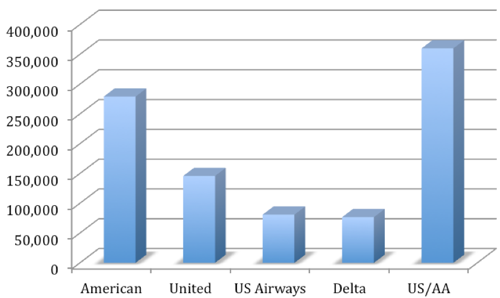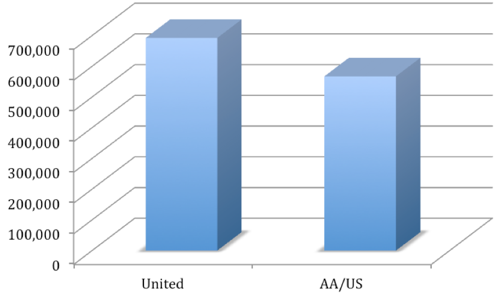American Airlines-US Airways merger might be necessary, but is it a good match?
American Airlines' (AA) bankruptcy has renewed discussion of the inevitability of an eventual merger with the other single in the room, US Airways. While perhaps expedient, is it a good match? A closer look at the shared dowries is in order.
- US Airways has a limited history as a major carrier, primarily formed through mergers and acquisitions.
- The airline has a modest international presence, with a small European network and no presence in Asia.
- US Airways has a strong presence in the Caribbean and Latin America, but lags behind its legacy peers in Asia.
- The merged airline would have eight hub cities, but the geographic mix is less appealing compared to other mergers.
- American Airlines' cornerstone strategy gives it dominance in Dallas and Miami, while US Airways dominates at its three hubs.
- A combined AA and US Airways would likely choose oneworld as their alliance, boosting oneworld's presence in New York and making US Airways' hubs oneworld hubs.
US Airways has no long history as a 'major carrier'
In stark contrast to its remaining legacy peers, the current US Airways is a product primarily of mergers and acquisitions between, and of, pre-deregulation regional carriers. Unlike United, American or Delta Air Lines, the airline's pre-deregulation network did not include transcontinental routes nor large aircraft. Even today, with only 26 aircraft, it has by far the smallest widebody fleet of any US legacy.
Caribbean, where it continues to maintain a substantial presence, but has only 16 European destinations (plus Tel Aviv) that are connected to its Philadelphia hub. Charlotte has six European destinations and the airline's only point in South America, Rio. From its Phoenix hub, it operates non-stop only to points in Mexico and Central America. The carrier's absence in Asia is conspicuous." />Caribbean, where it continues to maintain a substantial presence, but has only AUD21opean destinations (plus Tel Aviv) that are connected to its Philadelphia hub. Charlotte has six European destinations and the airline's only point in South America, Rio. From its Phoenix hub, it operates non-stop only to points in Mexico and Central America. The carrier's absence in Asia is conspicuous." />The airline also came late to international service. It initially focused on the Caribbean, where it continues to maintain a substantial presence, but has only 16 European destinations (plus Tel Aviv) that are connected to its Philadelphia hub. Charlotte has six European destinations and the airline's only point in South America, Rio. From its Phoenix hub, it operates non-stop only to points in Mexico and Central America. The carrier's absence in Asia is conspicuous.
Modest international presence
As a result of its small European network, the combination of American and US Airways still produces the smallest seat offering to Europe, with most services to duplicate European cities.
US-Europe weekly seats by US carrier: 28-Nov-2011 to 04-Dec-2011
A match in Latin America
However, the relatively strong Caribbean presence puts the AA/US Airways combination in a clear number one spot, and though US Airways brings little to the larger Latin America party, the combined airline still far outpaces its US legacy peers.
US/Latin America weekly seats by carrier: 28-Nov-2011 to 04-Dec-2011
US/Caribbean weekly seats by carrier: 28-Nov-2011 to 04-Dec-2011
Extremely weak in Asia
Despite US Airways having received route authority to a number of points in Asia, none of those services have been activated and the airline has no presence in Asia. As a consequence, the merged carrier continues to lag its legacy competition, with a mere 13% share of the seats supplied on a weekly basis by US legacies.
US/Asia Pacific weekly seats by carrier: 28-Nov-2011 to 04-Dec-2011
Given the growing influence of Asia in every aspect of global growth and development, this is a significant weakness for the standalone carriers and leaves the combined entity at a similar network disadvantage. United and Delta have seen their presence in Asia-Pacific increase following their respective merger with Continental and Northwest Airlines.
The hub question
The merged carrier would, at the outset at least, claim eight hub cities: American's New York JFK International Airport (JFK), Miami International Airport (MIA), Chicago O'Hare International Airport (ORD), Dallas/Fort Worth International Airport (DFW) and Los Angeles International Airport (LAX); as well as US Airways' Philadelphia International Airport (PHL), Charlotte Douglas Airport (CLT) and Phoenix Sky Harbor International Airport (PHX). The geographic mix is less appealing than the combinations that were evident when Northwest and Delta joined forces or in the case of United/Continental, which created an almost ideal distribution of focus cities.
Philadelphia is especially problematic in that it is less than a two-hour drive from Newark and for many in the Pennsylvania/New Jersey market its smaller network of international destinations makes Newark more attractive. Additionally, given American's extraordinary investment at JFK, the merged airline is unlikely to greatly expand the Philadelphia network.
And with substantial Asian access available at airports relatively nearby (JFK, Newark Liberty International Airport, Washington's Dulles), the case for significant growth at Philadelphia is hard to make.
US Airways proves little help at American's cornerstones
American's cornerstone strategy gives the carrier clear dominance only at Dallas and Miami, where it is by far the major presence. US Airways has the largest share at its three hubs, with almost complete dominance at Charlotte. However, American is in second place at New York JFK, Chicago O'Hare and Los Angeles. The addition of US Airways does not change that equation and the combined US Airways/AA grouping still trails the new United at both LAX and Chicago O'Hare. US Airways has little at JFK and does not add enough seats comparative to rival Delta. However, the combination does present a formidable challenge at LaGuardia.
Chicago O'Hare International Airport weekly capacity by seats: 28-Nov-2011 to 04-Dec-2011
Los Angeles International Airport weekly capacity by seats: 28-Nov-2011 to 04-Dec-2011
oneworld all but guaranteed
A combined AA and US Airways would be all but guaranteed to select oneworld as their alliance. With Delta in SkyTeam and United in Star Alliance, there would be no room - from a strategic or regulatory view - for a combined AA and US Airways in anywhere but oneworld. American Airlines also has significant east and west partnerships with oneworld carriers: anti-trust immunity with British Airways and Iberia across the Atlantic, immunity with Japan Airlines across the Pacific and a business agreement with Qantas. US Airways has little ties to Star and was overshadowed by United even before the United-Continental merger. It is also incomprehensible to think an alliance would have no major presence in the US, the world's largest domestic market.
If the two merge and select oneworld, oneworld's presence will be boosted in New York due to US Airways' large presence at La Guardia. US Airways' hubs of Charlotte, Philadelphia and Phoenix would become oneworld hubs because of US Airways' dominating presence. Some hubs and focus cities would be geographically close to each other. In the northeast US Airways' Philadelphia would likely shrink in favour of AA's New York hub while AA's small presence in Raleigh-Durham would decrease in favour of US Airways' Charlotte hub.
Is it love or simple availability?
Despite the flurry of talk about the inevitability of an AA-US Airways merger, the two airlines actually do not complement each other in ways that made Delta-Northwest and United-Continental much more logical outcomes. Merging their networks adds little new coverage, especially internationally, and still leaves the combined carrier a very weak presence in Asia.
Labour disputes are very likely. There are still contentions at US Airways about staff integration from its merger with America West. Unions at AA are notoriously feisty.
A320 family aircraft, which are the workhorse of US Airways' fleet. US Airways' B757s and B767s are due for retirement in the medium-term, as are AA's B757s and B767s. The A330 is the international workhorse at US Airways whereas AA relies on B777s. US Airways has 16 A330s, which would make a nice sub-fleet for AA to destinations that need capacity equivalent to the B777 without the range and extra unit cost of the B777. The merged airline – likely to use the American Airlines name – could look to have A330s take over AA's B777 European routes, allowing AA to re-deploy its B777s on longer and more high-yielding routes." />777 Eur" type="hidden" value="Fleet integration is workable, especially since AA has ordered A320 family aircraft, which are the workhorse of Airways' fleet. US Airways' B757s and B767s are due for retirement in the medium-term, as are AA's B757s and B767s. The A330 is the international workhorse at US Airways whereas AA relies on B777s. US Airways has 16 A330s, which would make a nice sub-fleet for AA to destinations that need capacity equivalent to the B777 without the range and extra unit cost of the B777. The merged airline – likely to use the American Airlines name – could look to have A330s take over AA's BAUD1,016opean routes, allowing AA to re-deploy its B777s on longer and more high-yielding routes." />Fleet integration is workable, especially since AA has ordered A320 family aircraft, which are the workhorse of US Airways' fleet. US Airways' B757s and B767s are due for retirement in the medium-term, as are AA's B757s and B767s. The A330 is the international workhorse at US Airways whereas AA relies on B777s. US Airways has 16 A330s, which would make a nice sub-fleet for AA to destinations that need capacity equivalent to the B777 without the range and extra unit cost of the B777. The merged airline - likely to use the American Airlines name - could look to have A330s take over AA's B777 European routes, allowing AA to re-deploy its B777s on longer and more high-yielding routes.
The matching not be as good as Delta-Northwest and United-Continental, but AA and US Airways are available, and if they believe they need merge benefits and synergies to reduce their cost base, they will also love each other.





